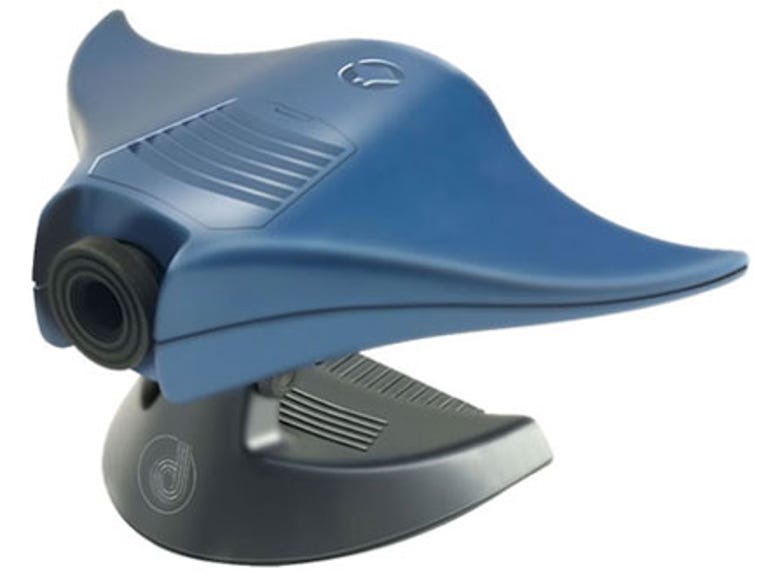 Why You Can Trust CNET
Why You Can Trust CNET Digislide MantaRay projector review: Digislide MantaRay projector
A projector in the shape of a stealthy sea beast? Novel idea, but not so good in terms of image quality.
Sometimes the fates just pick on people. Or even companies. Digislide's MantaRay LCD projector, an Australian product fashioned in the shape of that sand-scraping sea beast, appeared on the market in September 2006. That same month, Steve Irwin met his untimely end courtesy of a Queensland stingray, thereby linking the design and branding of the projector with the freak death of an Aussie icon.
The Good
The Bad
The Bottom Line
The timing was terribly unfortunate, especially given the MantaRay is the first product to be released by Digislide. But now that half a year has gone by, perhaps the association with the late Crocodile Hunter won't be the first thing people think when they see the device.
Design
Yep, it does look like a manta ray, but it's a simplified, stylised manta ray that's not too over-the-top. There are a few cute touches -- the vent on the top mimics a ray's gills, and the flared edges make it seem a lovable animal rather than a menacing scourge of the deep. We'd even compare it to a stealth bomber on account of its aerodynamic arrowhead shape (though the royal blue hue is none too subtle).
On the back of the MantaRay are three tiny (too tiny for our fleshy thumbs) unmarked buttons that adjust settings such as volume, brightness, contrast and colour. The centre button needs to be pressed multiple times according to what setting you want to change, and there is no general on-screen menu; the settings just scroll through individually at each press of the middle button.
The black base is large and sturdy, and echoes the triangular shape of the projector housing. A neat row of ports -- a coaxial input, three 3.5mm sockets for mono audio/video/headphones and a figure-eight power socket -- snuggle in alongside the on/off switch. We were surprised to see 3.5mm sockets, especially for composite video. Two plug adaptors are included, but the fact that any conversion from the standard RCA plugs is required struck us as odd.
On the underside of the MantaRay is a trapdoor allowing access to the lamp, which can be easily replaced at a cost of $99 for the new globe. The projector housing and the base are connected with a large thumbscrew that allows for adjustment of the projection angle -- 30 degrees is the prescribed sweet spot for undistorted viewing.
Features
The MantaRay bills itself as "the big entertainer", catering to TV, video and gaming rather than business. It is compatible with any device that sports a composite video output, such as DVD players, camcorders, portable video players (including iPods) and games consoles.
One good thing about the MantaRay is that you don't need to sit around twiddling your thumbs while the lamp wams up; this is a plug-and-play projector.
Performance
A telescopic TV antenna is included in the box, but you're unlikely to get a decent signal from it. Better to plug the MantaRay into a wall outlet or even a set-top box if you're really keen on watching projected TV.
Resolution is a big issue with this projector. The specs quote 181,470 pixels, which is significantly below 640 by 480. Although we've been spoiled by having access to 1080p models, we still think the average home user will find the picture too grainy. We tested the MantaRay at the recommended display size of 1.5 metres (measured diagonally), and within two metres of the image, the individual colours comprising each hexagon of the honeycomb were clearly visible, and the "screen door" effect marked.
Television channels tuned in well with the auto-scan feature, but we had some trouble with an LG DVD player. Last of the Samurai showed up in black and white, with horizontal bars marring Tom Cruise's angsty antics. Adjustments to the colour settings and double-checking of connections provided no joy, and we were not able to get a watchable image using the DVD player as a source.
Although you can get sound from the MantaRay, you may not want to. Maximum volume is relatively quiet, and distortion noticeable.
$1349 isn't that much coin to lay down as far as projectors go, but even so, it's a lot to spend on an item that delivers unsatisfying image quality. The MantaRay might find a home among people who fancy a portable all-in-one projector with a quick start-up time, but the low resolution and DVD compatibility issues (reflected in our score) mean it's a device we wouldn't recommend.


